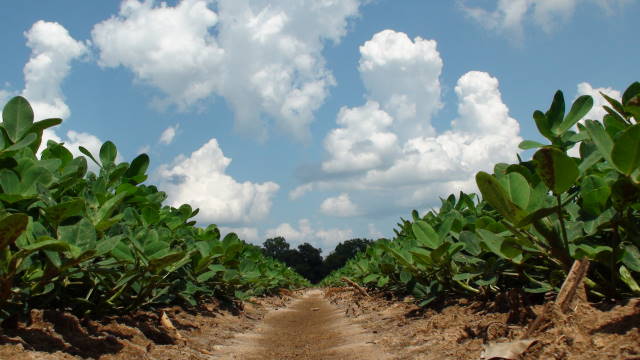
Take a pegging soil sample, and if you have at least 500 lb/a of soil test calcium AND if your calcium to potassium ratio is 3:1 or better, then you don’t need to apply gypsum. Photo credit: John Atkins
Glen Harris, UGA Soil Extension Specialist
When we switched from growing small-seeded Georgia Green to large-seeded Georgia 06G we really thought we would need to increase our gypsum or calcium recommendations. But after years of research we concluded that the recommendations didn’t need to change. You can still use a pegging soil sample ( 3 inches deep, next to the peanut row soon after emergence) and if you have at least 500 lb/a of soil test calcium AND if your calcium to potassium ratio is 3:1 or better, then you don’t need to apply gypsum. If you do not meet EITHER of these requirements then you need to apply 1000 lb/a gypsum at early bloom. Also, all peanuts grown for seed should automatically receive this gypsum application, regardless of soil test calcium levels.
There are a number of different gypsum or landplaster fertilizers currently available. Chemically they are all calcium sulfate, and the good news is that we have tested these too and they are all comparable, as far as providing calcium to the pegging zone of a peanut. Probably the most commonly one used now is technically called Flue Gas Desulfurized or FGD gypsum and is a byproduct of scrbbing sulfur gas out of smokestacks at coal burning power plants. I call this “smokestack” gypsum although a lot of growers refer to it as “synethetic” gypsum. There is also the old “wet bulk” phosphogypsum (a by-product of the phosphorous fertilizer production) and the naturally mined USG 500 among others.
Agricultural lime can also be used to provide calcium to the pegging zone of peanut but there are a few things to consider : 1) this method should really only be used when you also need a soil pH adjustment, otherwise use gypsum if you need calcium, 2) both dolomitic or calcitic lime can be used. Some people think you HAVE to use calcitic but this is not true, and 3) the lime method does not work as well as gypsum under dryland conditions during years of normal rainfall. We have good replicated field data to support this too.
We have also been testing calcium chloride applied though a pivot at peak pod fill (60-90 days after planting). This method has a fit when you are on the borderline of needing some calcium. The benefits are you can apply this yourself and you do not have to run over the vines. One disadvantage, compared to gypsum or lime, is that this method with not build your soil test calcium levels basically at all.
For more information on peanut production:
